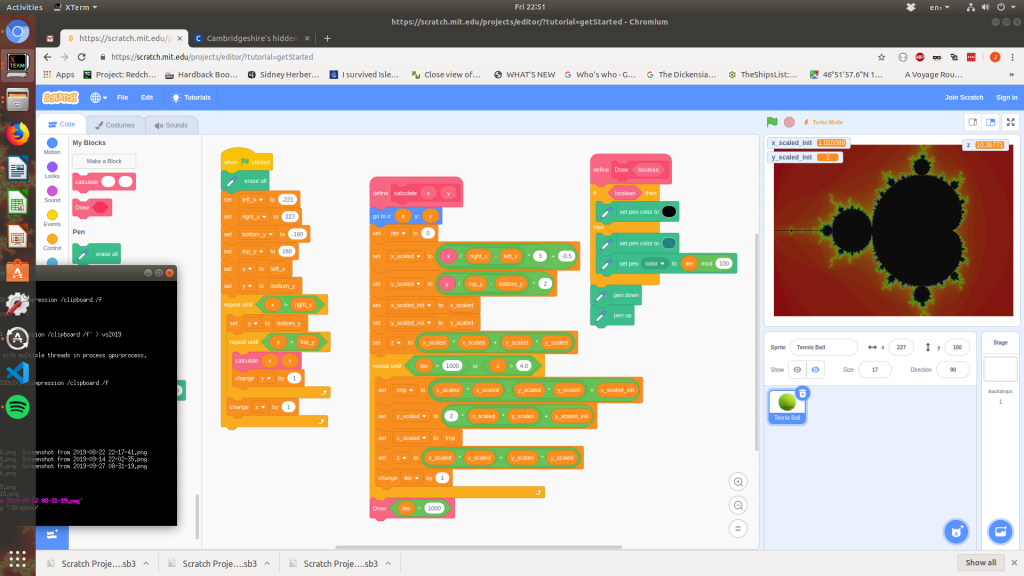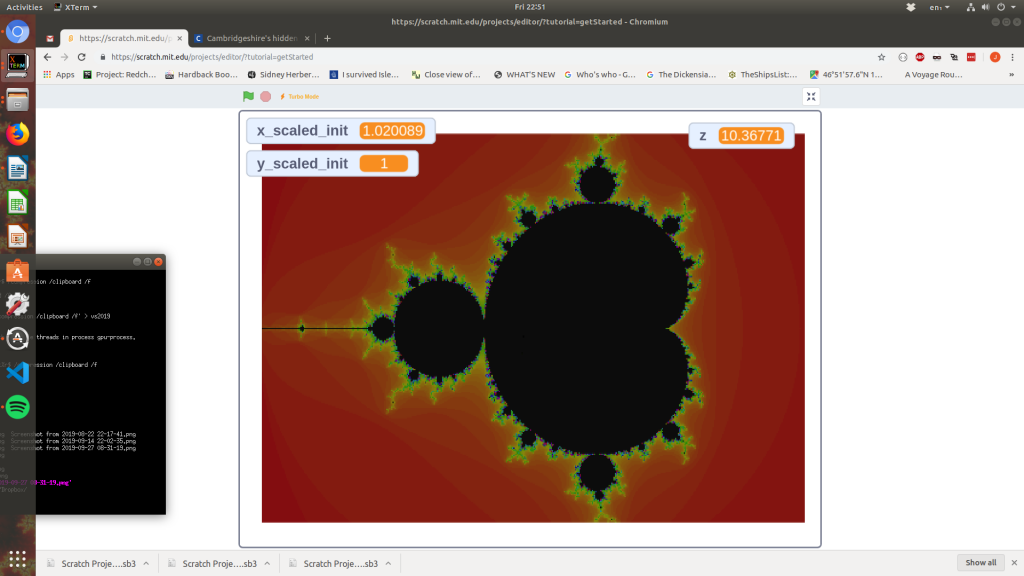- https://isc.sans.edu/diary/Introduction+to+analysing+Go+binaries/24770
- https://docs.google.com/document/d/1lyPIbmsYbXnpNj57a261hgOYVpNRcgydurVQIyZOz_o/pub
- https://github.com/dor2727/golang_function_rename
- https://tuanlinh.gitbook.io/ctf/golang-function-name-obfuscation-how-to-fool-analysis-tools
- https://gitlab.com/zaytsevgu/goutils/blob/master/go_renamer.py
- https://harpaz.wordpress.com/category/golang/golang-internals/
Author Archives: admin
Mandelbrot Scratch

By the magic of the Pen extension, Scratch can plot coloured pixels. “Turbo Mode” is also a help here, for speed. Oddly you can set the colour (0-100) with a single command, but not the saturation and brightness, so you have to set the pen to a phoney colour if it was black before.
Of course (?) you need a fake sprite to attach the program to, in this case it’s an invisible tennis ball.

Scaling the screen to the Mandelbrot domain – x in [-1, 2.5], y in [-1,1] – is a bit trial and error when working out how big the screen is pixels, but the result is good enough.
HOWTO: grpc-gateway server in Go
Imagine we have a simple protobuf definition, below. It defines a message called Fen which contains a single string field, fen, and an RPC call, Position, which takes no parameters and returns a Fen message.
(FEN is Forsyth-Edwards Notation, a compact text format for describing the state of a game of chess)
syntax = "proto3";
package chess;
import "google/protobuf/empty.proto";
import "google/api/annotations.proto";
service Chess {
rpc Position (google.protobuf.Empty) returns (Fen) {
option (google.api.http) = {
get: "/position"
};
};
};
message Fen {
string fen = 1;
};
We want to make a REST server implementing the interface defined by the protocol buffer. Using the namely/gen-grpc-gateway container, this is relatively simple to do. First we generate the protobufs code for the Go language (the ‘-l go‘ switch) which we’ll need for the grpc server (or clients). Then we generate the REST gateway itself.
#!/bin/bash GOPATH=/home/xxx/yyy export GOPATH PROTOC_CONTAINER=namely/protoc-all:1.11 GRPC_GATEWAY=namely/gen-grpc-gateway:latest ME=$(id -u):$(id -g) docker pull $PROTOC_CONTAINER docker run \ --user $ME \ --rm \ -v $PWD/proto:/defs \ $PROTOC_CONTAINER -d /defs -l go docker run \ -v $PWD/proto:/defs \ --user $ME \ $GRPC_GATEWAY -f /defs/chess.proto -s Chess docker build -t my-grpc-gateway proto/gen/grpc-gateway cd src/server go get && go install go build .
This done, we can implement the grpc server using the generated code, which we import:
package main
import (
"context"
"fmt"
"log"
"net"
"server/pb-go" // Generated code
"github.com/golang/protobuf/ptypes/empty"
"google.golang.org/grpc"
)
type chessServer struct {}
func (c *chessServer) Position(ctx context.Context, empty *empty.Empty) (*chess.Fen, error) {
return &chess.Fen{Fen: "zzzzz"}, nil
}
func main() {
lis, err := net.Listen("tcp", fmt.Sprintf(":%d", 8080))
if err != nil {
log.Fatalf("failed to listen: %v", err)
}
log.Print("Listening on port 8080 (grpc)")
grpcServer := grpc.NewServer()
chess.RegisterChessServer(grpcServer, &chessServer{})
grpcServer.Serve(lis)
}
Then, the system is completed by launching the grpc REST gateway and the grpc server at the same time. Usually this would be done via docker-compose to wrap them both up nicely, but I haven’t bothered here.
#!/bin/bash
docker stop grpcgate
docker run \
--rm \
--name "grpcgate" \
-d \
-p 9000:80 \
my-grpc-gateway --backend=192.168.1.8:8080
echo "GRPC gateway on localhost:9000"
./src/server/server
